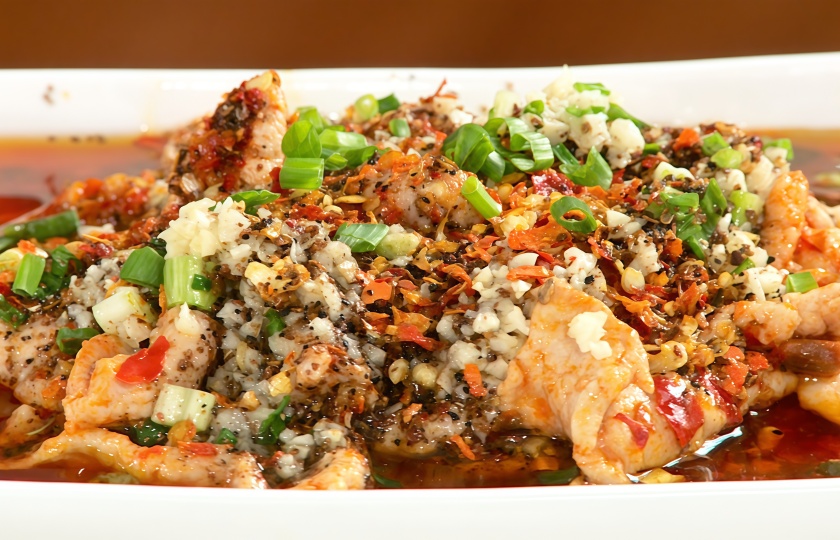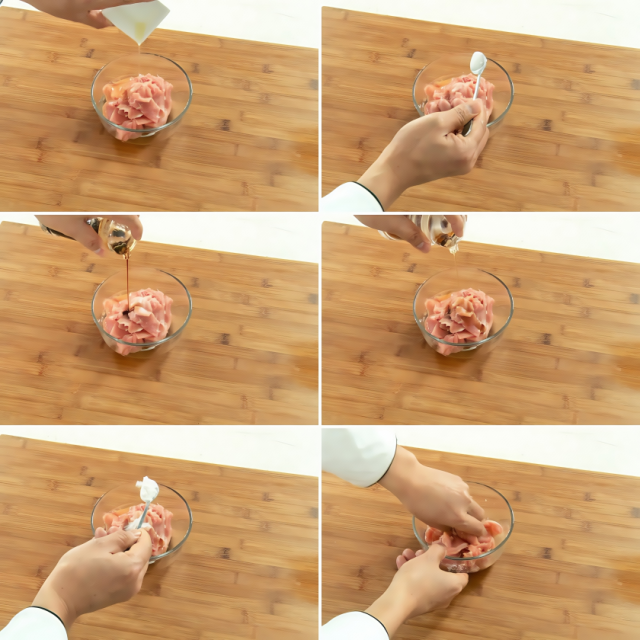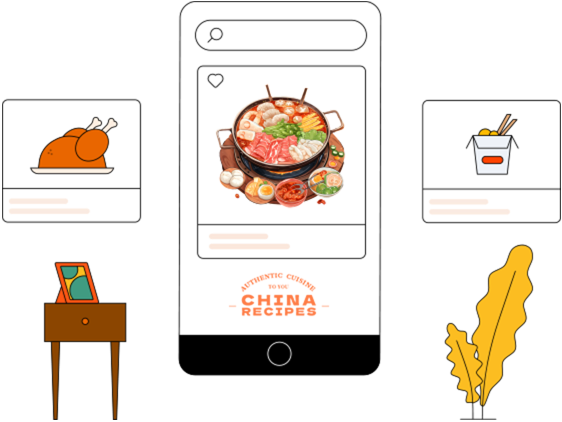Sichuan Boiled Pork(Shui Zhu Rou Pian 水煮肉片)


Sichuan Boiled Pork, a signature dish of Sichuan cuisine, holds simple yet irresistible flavors in its numbing and spicy broth.
What is Sichuan Boiled Pork?
The name "Sichuan Boiled Pork" is the most deceptive name in Sichuan cuisine. Clearly soaked in bright red and spicy oil, it still claims to be just "boiled."
The essence of this dish lies in the combination of tender sliced meat and spicy, flavorful soup, paired with crispy side dishes like bean sprouts, creating a quadruple taste of "numbing, spicy, fresh, and hot."
Pouring hot oil brings out the spiciness and fragrance. The tender sliced meat should slide off the tongue to be considered qualified.
People in Chongqing like to use sliced lettuce, while those in Beijing love to add Chinese cabbage stalks. I've found that using sliced zucchini as a substitute is also a good choice. The beauty of this dish lies right here: it's extremely spicy, yet it can accommodate countless variations.

Ingredient Explanation and Substitutions
Pork loin: The traditional choice. The lean meat is tender and not tough. If you're short on time, you can use thinly sliced chicken breast as a substitute. Add half a spoonful of oil during marination to lock in the moisture.
Bean sprouts: They provide a crispy texture. If you can't get them, you can use shredded cabbage or celery sticks. Blanch them for 30 seconds to keep them crispy.
Pixian doubanjiang (chili bean paste): Choose the one with more red oil. As a substitute, you can use chili sauce and add half a spoonful of light soy sauce, and a little brown sugar to enhance the freshness.
Chili powder: Coarse - grained chili powder has a stronger aroma. If you're afraid of spicy food, you can choose paprika, which retains the flavor but reduces the spiciness by half.
Cornstarch: Either potato starch or regular cornstarch is fine. The key is to coat the sliced meat to form a tender protective layer.
Hot oil: It is recommended to use high - temperature - resistant rapeseed oil to avoid the bitterness of olive oil at high temperatures.
Sichuan pepper powder: Freshly ground has the best flavor. If you don't have it, you can use black pepper mixed with a little five - spice powder to simulate the layered flavor.
Tool Preparation
Wide - mouthed Wok: A cast - iron wok has excellent heat - retaining properties. When sautéing the doubanjiang (chili bean paste) until fragrant, it's less likely to burn at the bottom. A wok with a large curved bottom is convenient for stir - frying, and the ingredients are heated more evenly when thickening the soup.
Heat - resistant Soup Bowl: For serving Sichuan Boiled Pork, a coarse ceramic or high - temperature - resistant glass bowl is the first choice as it won't crack when pouring hot oil. It is recommended that the diameter of the bowl mouth be over 25 cm, providing enough space for the side dishes to spread out.
Long - handled Oil Ladle: Use a stainless - steel ladle with a spout for pouring hot oil, which allows for more precise oil control. Some people have tried using a latte art pitcher as a substitute, and surprisingly, its curved spout works well.
Mesh Strainer: When blanching the bean sprouts, use a fine - mesh strainer. It can not only drain the water but also be directly used as a container for holding the vegetables. Keep plenty of kitchen paper on hand. Drying the moisture of the ingredients is the key to maintaining a stable oil temperature.
INGREDIENTS
Main Ingredients
-
·350g pork loin (thinly sliced)
Additional Ingredients
-
·500g bean sprouts (trimmed and washed)
-
·20g scallions (chopped)
-
·20g garlic (minced)
Seasonings
-
·9g salt
-
·5ml light soy sauce
-
·5ml cooking wine
-
·10g cornstarch
-
·2g salt (for stir - frying bean sprouts)
-
·50g doubanjiang (chili bean paste)
-
·10g chili powder
-
·10g Sichuan pepper powder
-
·30ml cooking oil (for enhancing the aroma at the end)
COOKING STEP
Step 1
First, cut 350g of pork loin into thin slices as evenly as possible and put them into a bowl.

Step 2
Then, add 1 egg white, 4g of salt, 5ml of light soy sauce, 5ml of cooking wine and 10g of cornstarch. Mix well and marinate for 5 minutes to let the slices absorb the flavors.

Step 3
While marinating the meat, prepare the side ingredients: Trim and wash 500g of bean sprouts, chop 20g of scallions and mince 20g of garlic for standby.

Step 4
After 5 minutes of marination, heat the pan, add 20ml of oil and put the bean sprouts into the pan. Stir - fry them quickly for several times.

Step 5
Then, sprinkle 2g of salt and stir - fry evenly until the bean sprouts become a little soft. Transfer them to a plate for standby.

Step 6
Add more oil to the pan, put in 50g of doubanjiang and stir - fry slowly over low heat until it becomes loose. After getting the red oil, add 300ml of water, stir well, then add 5g of salt. Bring it to a boil over high heat to make a red and spicy soup in the pan.

Step 7
When the water is boiling, carefully put the marinated slices into the pan and stir gently. Once the slices change from red to white, which means they are cooked. As soon as the soup boils again, immediately scoop out the soup and the slices together and pour them over the bean sprouts.

Step 8
Sprinkle 10g of chili powder and 10g of Sichuan pepper powder over the slices and bean sprouts, then evenly distribute the chopped scallions and minced garlic on top.

Step 9
Finally, heat 30ml of oil until boiling hot (smoky).

Step 10
Pour the hot oil directly over the chopped scallions and minced garlic. Thus, the Sichuan Boiled Pork is completed.

More Sichuan Recipes Worth Trying
Bobo Chicken: Sichuan's Skewered Sensation
Ma La Xiang Guo (Sichuan Mala Dry Pot) Recipe
Authentic Sichuan Delicacy: Sweet Noodles
How to Keep Sliced Pork Tender?
Choose the Right Cut: Pork loin and plum blossom meat have delicate fibers, and their fat marbling resembles snowflakes. When cutting the meat, cut against the grain, severing the muscle fibers, so the slices will naturally not be tough.
Marinating Secrets: Egg white makes the meat smoother and more tender than whole eggs. Mix cornstarch with water to form a paste. When coating the meat, it's like putting a protective film on the slices. Adding half a spoonful of oil seals in the moisture. Refrigerating for 20 minutes allows the flavor to penetrate better than a hasty marinade.
Cooking Heat is Key: Stir - frying in a hot pan with cold oil is the safest method. Take the slices out of the pan immediately as soon as they turn white. If making a boiled dish like this, turn off the heat after the soup boils and let the meat cook in the residual heat. The remaining warmth will make the meat tender just right.
Emergency Tips: If you don't have egg white, you can use unsweetened yogurt instead. The lactic acid can tenderize the meat. Some people have tried marinating the meat in pineapple juice for 10 minutes, and the tenderizing effect is comparable to professional meat tenderizer.
Knife Skills Details: It's easier to cut meat when it's half - frozen. Keep the thickness at around 3 millimeters. Try to make the slices as uniform in size as possible so they will be evenly heated and not become tough.
Oil Temperature Control: When stir - frying sliced pork, the ideal oil temperature is around 150°C (medium - low heat, when you insert a chopstick into the oil and small bubbles form around it). If the oil is too hot, the outside of the meat will burn while the inside remains raw. If the oil is too cool, the coating on the meat is likely to come off.
Variations and Innovations
Try a Different Main Ingredient: Beef slices are more resistant to boiling than pork. After slicing, pound the beef to loosen the fibers. For the seafood version, use fresh shrimp or squid rings. The boiling time can be halved, and drizzle with rattan pepper oil before taking the dish out of the pot to enhance the freshness.
Add Layers of Spiciness: Replace ordinary chili powder with Guizhou smoked chili powder to highlight the charred aroma. Use Yunnan Danshan dipping sauce to prepare the soup base, which has a complex flavor of twenty spices, saving the step of stir - frying the bean paste.
The Vegetarian Version is Also Wonderful: Cut old tofu into thick slices and fry until a crispy crust forms. Use it to replace the sliced meat and let it soak up the soup. Change the base vegetables to enoki mushrooms and black fungus, and finally sprinkle with dried shiitake mushroom powder to enhance the freshness.
Reduce Oil Without Compromising Flavor: Instead of pouring hot oil to release the aroma, use an oven. Spread the spices on top of the sliced meat and bake at 200°C for 3 minutes. This method can achieve a fragrant aroma using 30% less oil than the traditional way.
Change the Soup Base: Add two spoons of sesame paste to the red soup to immediately give it the rich taste of a hot pot restaurant. Some people have tried using pickled vegetable juice to replace part of the water, adding a new, appetizing sour - spicy flavor.
Cold - eating Method: Soak the cooked sliced meat in ice - cold soup, similar to Sichuan cold skewers. After being refrigerated, the spicy and numbing flavors penetrate the meat, making it suitable to be paired with beer in summer.
Consumption Suggestions
Optimal Tasting Time: Eat immediately after plating. The texture is the most moist when the red oil coating the sliced meat has not solidified, and the crispness of the bean sprouts can last for about 12 minutes.
Spiciness Reduction Tips: After reducing the amount of chili powder, sprinkle a little cooked sesame seeds to supplement the aroma; use Dahongpao Sichuan pepper powder instead, as its numbing flavor is milder and less likely to cause choking.
Vegetarian and Non - vegetarian Combinations: The bottom vegetables can be replaced with sliced asparagus lettuce or baby cabbage, which will be sweeter after soaking up the soup.
Oil Temperature Control: When pouring the hot oil, insert a chopstick into the oil pot. If fine bubbles form around the chopstick, it indicates the right temperature. Pour the oil in three times for a more even distribution.
Low - oil Version: Replace the red oil soup base with a mixture of tomato puree and Korean spicy sauce. Substitute the step of pouring hot oil with using a culinary torch to roast the spices, creating a unique flavor with fewer calories.

















